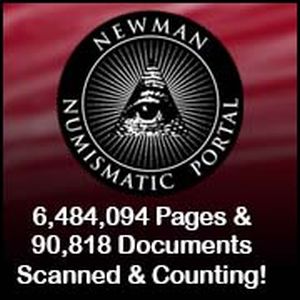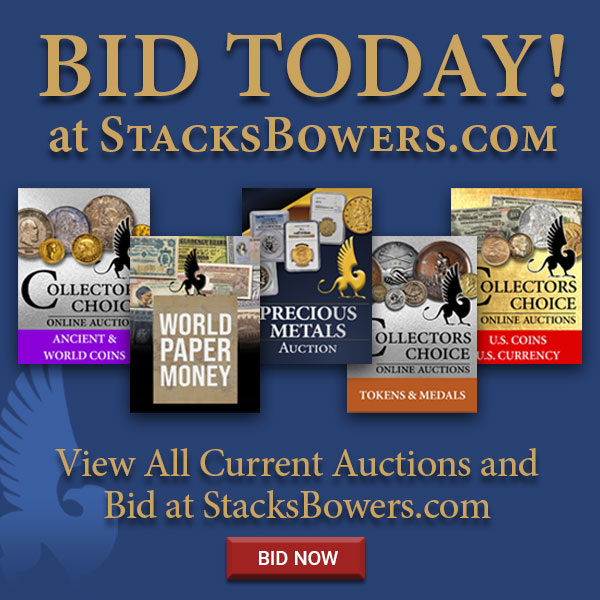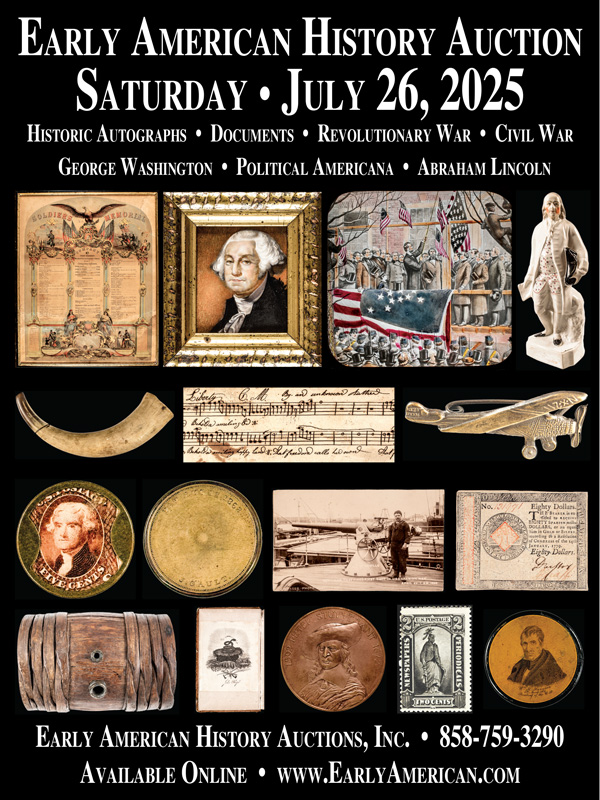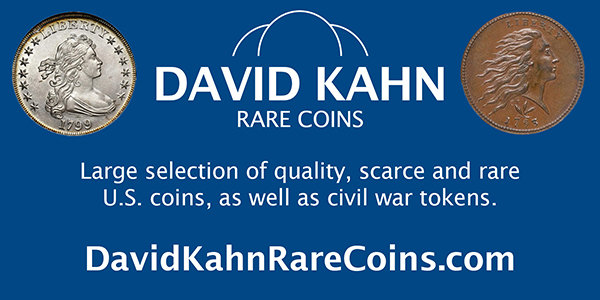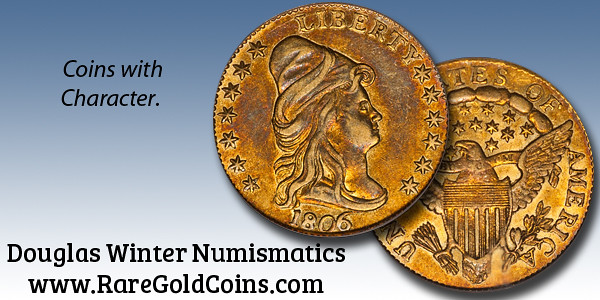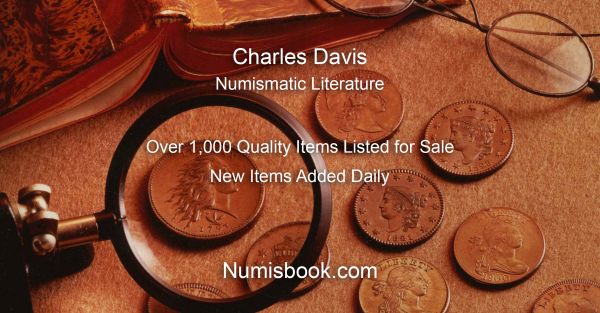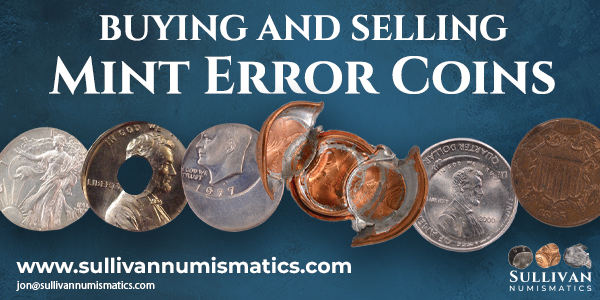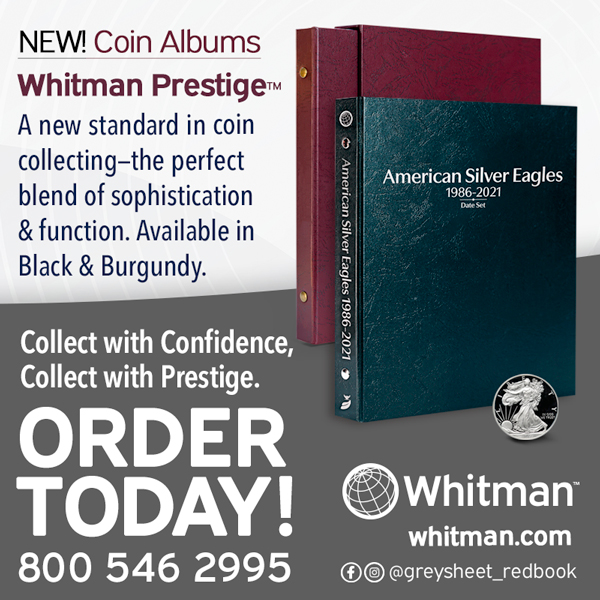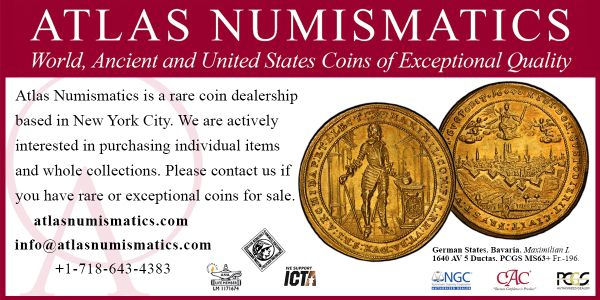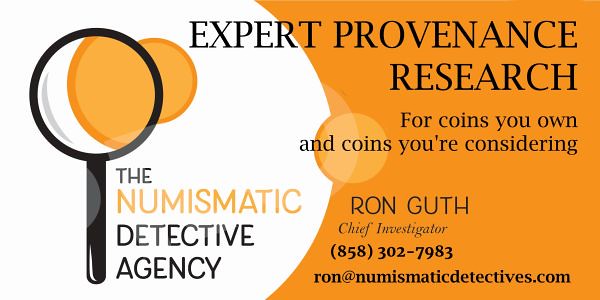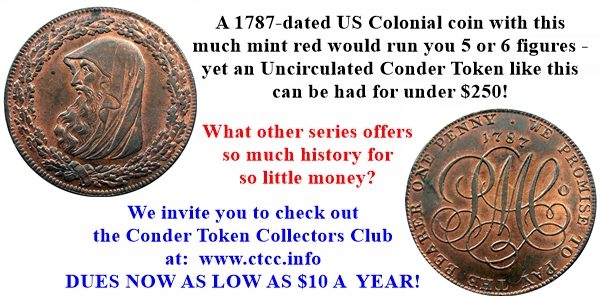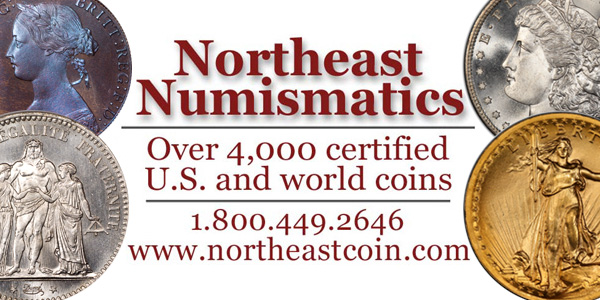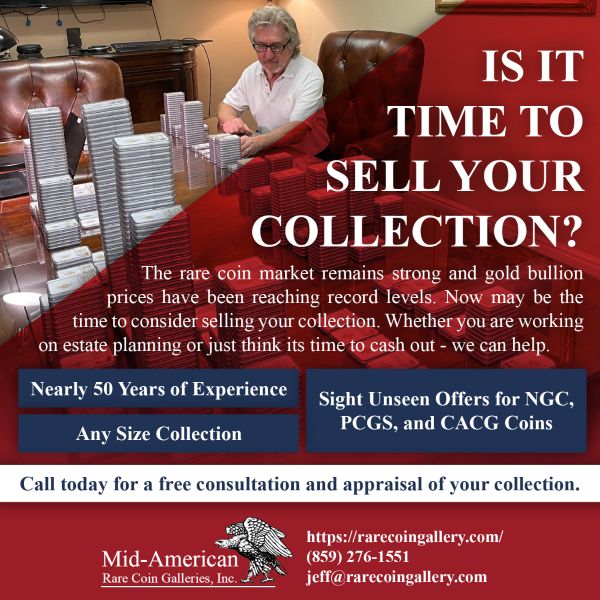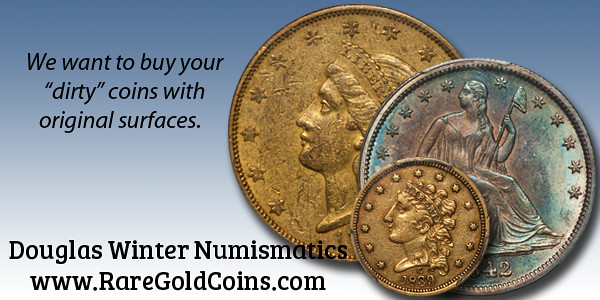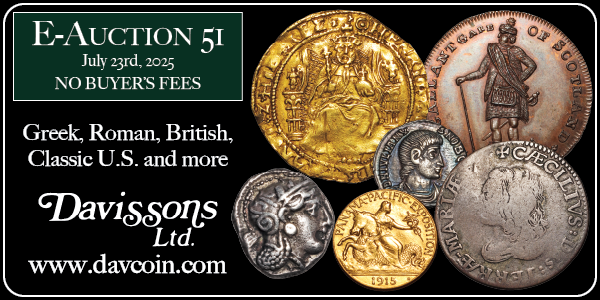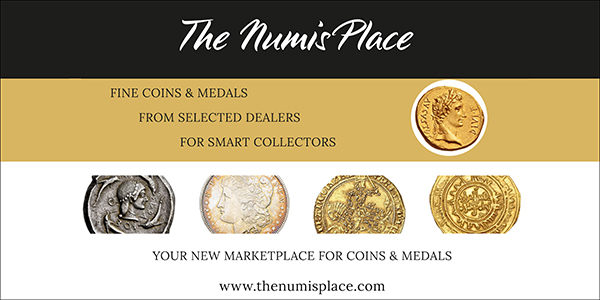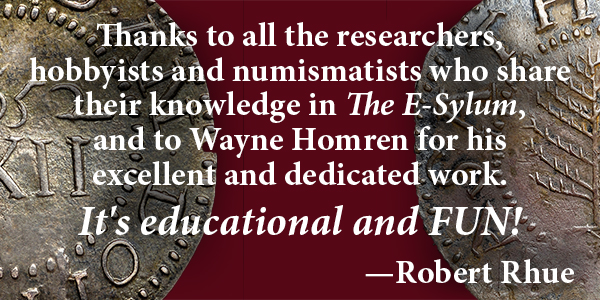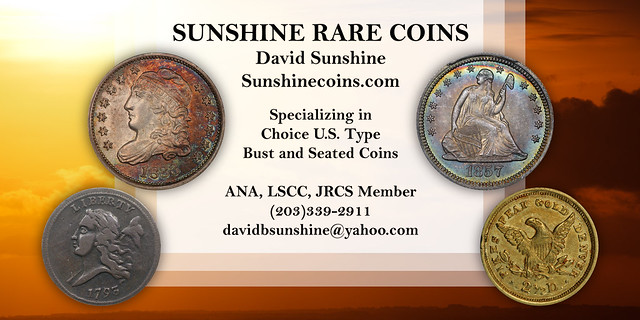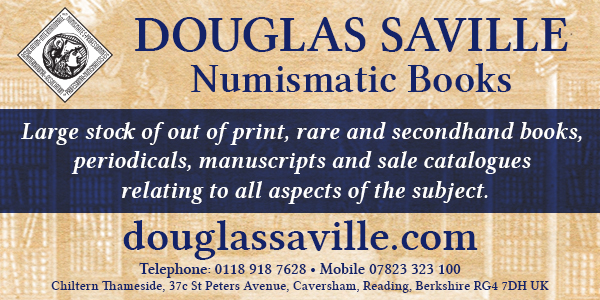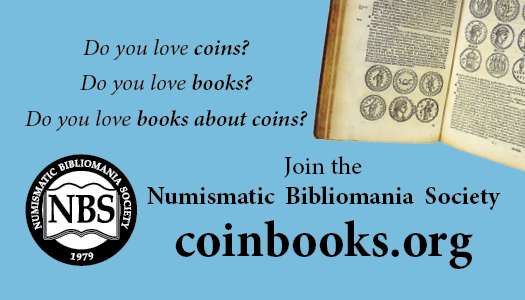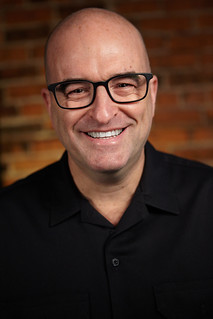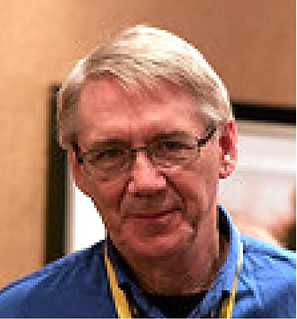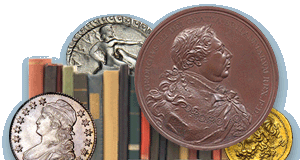
Visit our NBS Sponsors
About UsThe Numismatic Bibliomania Society is a non-profit association devoted to the study and enjoyment of numismatic literature. For more information please see our web site at coinbooks.org SubscriptionsThose wishing to become new E-Sylum subscribers (or wishing to Unsubscribe) can go to the following web page link MembershipThere is a membership application available on the web site Membership Application To join, print the application and return it with your check to the address printed on the application. Print/Digital membership is $40 to addresses in the U.S., and $60 elsewhere. A digital-only membership is available for $25. For those without web access, write to: Jeff Dickerson, Treasurer AsylumFor Asylum mailing address changes and other membership questions, contact Jeff at this email address: treasurer@coinbooks.org SubmissionsTo submit items for publication in The E-Sylum, write to the Editor at this address: whomren@gmail.com BUY THE BOOK BEFORE THE COINSale Calendar
|
- WAYNE'S WORDS: THE E-SYLUM JULY 20, 2025
- KOLBE & FANNING BCD LIBRARY WEB SALE #1
- LANG NUMISMATIC LITERATURE AUCTION 7 REMINDER
- NEW BOOK: KIDS LOVE COINS!
- NEW BOOK: POLISH COPPER COINS OF AUGUSTUS III
- NEW BOOK: BRITISH METHODIST MEDALS AND TOKENS
- NEW BOOK: STRIKING GOLD IN ALASKA, 8TH EDITION
- PERIODICAL: TAMS JOURNAL JULY-AUGUST 2025
- PERIODICAL: MCA ADVISORY SUMMER 2025
- PERIODICAL: 300TH ISSUE OF THE SHEKEL
- NEWMAN PORTAL ADDS MINT REPORTS
- VIDEO: DAN HOLMES LARGE CENT HIGHLIGHTS
- BOB LEONARD ON THE MAINE PENNY
- NOTES FROM E-SYLUM READERS: JULY 20, 2025
- NUMI V3: AI COIN SORTING PROTOTYPE DEMO
- VOCABULARY TERM: RIBBON LIFT
- GEORGE FREDERICK KOLBE (1941-2025)
- PAUL HOLLIS NOMINATED FOR U.S. MINT DIRECTOR
- NUMISMAGRAM MEDAL SELECTIONS: JULY 20, 2025
- HERITAGE: CALIFORNIA FRACTIONAL GOLD SHOWCASE
- WAYNE'S NUMISMATIC DIARY: JULY 20, 2025
- EXETER MUSEUM'S KING ALFRED THE GREAT COIN
- CURIOUS NUMISMATIC JUDAICA
- 1721 PIRATE TREASURE DISCOVERED
- COINS FROM USS YORKTOWN SHIPWRECK RETURNED
- ABOUT THIS ISSUE: JULY 20, 2025
Content presented in The E-Sylum is not necessarily researched or independently fact-checked, and views expressed do not necessarily represent those of the Numismatic Bibliomania Society.
WAYNE'S WORDS: THE E-SYLUM JULY 20, 2025
 Thank you for reading The E-Sylum. If you enjoy it, please send me the email addresses of friends you think may enjoy it as well and I'll send them a subscription. Contact me at whomren@gmail.com anytime regarding your subscription, or questions, comments or suggestions about our content.
Thank you for reading The E-Sylum. If you enjoy it, please send me the email addresses of friends you think may enjoy it as well and I'll send them a subscription. Contact me at whomren@gmail.com anytime regarding your subscription, or questions, comments or suggestions about our content.
This week we open with two literature sales, four new books, three periodicals, updates from the Newman Numismatic Portal, the Maine Penny, and more.
Other topics this week include British Methodist medals, the MCA Advisory, U.S. Mint Reports, ribbon lifts, George Kolbe, Paul Hollis, California fractional gold, King Alfred the Great, curious numismatic Judaica, and pirate treasure.
To learn more about Polish Copper Coins of Augustus III, the Thomas Spence Indian Token, Halliday's Badge of Distinction, the Numi AI coin sorting prototype, the Alaska–Yukon–Pacific Exposition medal, coin buttons of Ferdinand VII and Isabella II, Queen Victoria Gold Medals, and Mike Markowitz's Top Ten Medieval Coins, read on. Have a great week, everyone!
Wayne Homren
Editor, The E-Sylum
KOLBE & FANNING BCD LIBRARY WEB SALE #1
Numismatic Booksellers Kolbe & Fanning have announced a new web sale closing Thursday, July 31, 2025. Here's the announcement. -Garrett
Kolbe & Fanning Numismatic Booksellers are pleased to announce that we will be holding a Web Sale of selections from the extraordinary BCD Library on Thursday, July 31. Our Web Sales generally focus on useful but lower-price books, catalogues and other numismatic publications, and this initial offering in this format of material from the BCD Library includes publications on a wide variety of topics, mostly pertaining to antiquity, all of which are listed with a starting price of only $10. The online catalogue can be accessed at bid.numislit.com. There is no printed catalogue.
Along with more commonly available references, a number of rarities and other delicacies are included. Some highlights of this first Web Sale include:
Register early to bid online
Kolbe & Fanning use Auction Mobility as our third-party online bidding platform, which is separate from our retail site. Auction Mobility is an app-based platform allowing users the ability to participate in the sale through phones, tablets and computers. To register for the sale, bidders must go to bid.numislit.com and sign up. Once you have set up an account, you may browse lots, place advance bids, or participate in the live sale online. Those wishing to participate on their devices can download the Kolbe & Fanning app through the Apple or Google Play Store.Kolbe & Fanning Numismatic Booksellers LLC is a licensed and bonded auction firm in the State of Ohio, and our sales are conducted by licensed auctioneers. For more information, please see the Kolbe & Fanning website at numislit.com or email David Fanning at df@numislit.com. To register for the sale, go to bid.numislit.com. We look forward to your participation.
LANG NUMISMATIC LITERATURE AUCTION 7 REMINDER
Here's a reminder from Michael Lang of the upcoming numismatic literature sale from Numismatisches Antiquariat Lang GmbH. -Editor
This is a reminder of our upcoming 7th auction of numismatic literature, which will take place on July 29, 2025. Discover rare treasures and important works of numismatic art, including duplicates from the BCD-library.
Details:
- Date: July 29, 2025
- Location: Online on Auex.de
- Start: 4:00 p.m. (CEST)
Please register in advance to participate. You can view the current PDF catalog on Auex as well as on our homepage. Take the opportunity to discover your favorites and submit pre-bids.
If you have any questions, please contact us at info@numismatisches-antiquariat.de. We look forward to your participation!
For more information, or to bid, see:
https://auktionen.numismatisches-antiquariat.de/de-de/auctions/current
To read the earlier E-Sylum article, see:
LANG NUMISMATIC LITERATURE AUCTION 7
(https://www.coinbooks.org/v28/esylum_v28n28a03.html)
NEW BOOK: KIDS LOVE COINS!
Whitman has published a new book for introducing young children to coins. Great news - stock up for birthdays and holidays. -Editor
 Whitman is thrilled to announce the upcoming release of
Kids Love Coins!, a joyful and engaging introduction to the world of coin collecting for young
readers. Written by acclaimed children's author Charles Ghigna—widely known as Father
Goose®—and Andi Martin, and brought to life by illustrator Jacqueline East, this beautifully
crafted 32-page picture book is designed to spark curiosity and inspire a lifelong love of coins in
children ages 3 and up.
Whitman is thrilled to announce the upcoming release of
Kids Love Coins!, a joyful and engaging introduction to the world of coin collecting for young
readers. Written by acclaimed children's author Charles Ghigna—widely known as Father
Goose®—and Andi Martin, and brought to life by illustrator Jacqueline East, this beautifully
crafted 32-page picture book is designed to spark curiosity and inspire a lifelong love of coins in
children ages 3 and up.
One of our key roles in the numismatic community is to ensure the hobby endures by inspiring
young collectors,
said John Feigenbaum, President and CEO of Whitman Brands. This book is a
perfect example of that mission in action. Kids Love Coins! is the ideal way to get children excited
about coins—especially as we look ahead to the 250th anniversary of the United States in 2026!
From Lincoln cents to Kennedy half dollars and beyond, Kids Love Coins! presents fascinating facts about U.S. coins—what they're made of, who and what is featured on them, where they're minted, and how they are used—all in rhyming verse paired with vivid, full-color illustrations. Children will also learn the parts of a coin, basic coin terminology, and the joys of starting their own collection.
It was fun and refreshing to help bring this project to life,
said Matt Jeffirs, Creative Director at
Whitman Brands. The artwork by Jacqueline East is just so beautiful—it captures the spirit of
childhood discovery and wonder that's at the heart of the hobby.
Whitman is no stranger to children's publishing. Under former ownership, Whitman's imprint Dalmatian Press produced a successful line of coloring books and children's books in the early 2000's. Continuing that tradition, Kids Love Coins! marks an exciting new chapter in Whitman's efforts to make numismatics accessible and exciting for all ages and experience levels.
Charles Ghigna—aka Father Goose®—is the author of more than 5,000 poems and 250 books for children and adults. His work spans beloved titles like The Father Goose Treasury of Poetry and The Very Hungry Caterpillar's First Poems, as well as more reflective pieces like his Pulitzer Prize-nominated Returning to Earth. He also penned Alabama My Sweet Home, published by Whitman in 2018 to celebrate the state's bicentennial, which became a beloved favorite for its vibrant depiction of Alabama's people, places, and history.
Whether your child is discovering coins for the first time or already has a budding collection, Kids Love Coins! is a delightful, educational, and accessible entry point into the world of numismatics. With catchy rhymes, captivating art, and real-world learning, it's sure to become a treasured addition to young readers' bookshelves—and coin boxes!
Published by Whitman®, the most trusted name in numismatic literature, Kids Love Coins! is now available for pre-order at Whitman.com and Amazon. It will also be available at Whitman's Ebay Store, Walmart.com, and bookstores, hobby shops, and other authorized retailers nationwide August 5, 2025.
For more information, visit www.whitman.com.
About the Author
 Charles Ghigna - Father Goose® lives in a tree house in the middle of Alabama. He is a poet,
children's author, nationally syndicated feature writer, and the author of more than 5,000 poems and
250 books and anthologies for children and adults from the 1990 Pulitzer Prize nominee Returning
to Earth to the popular children's books The Very Hungry Caterpillar's First Poems illustrated by
Eric Carle and The Father Goose Treasury of Poetry: 101 Poems for Children.
Charles Ghigna - Father Goose® lives in a tree house in the middle of Alabama. He is a poet,
children's author, nationally syndicated feature writer, and the author of more than 5,000 poems and
250 books and anthologies for children and adults from the 1990 Pulitzer Prize nominee Returning
to Earth to the popular children's books The Very Hungry Caterpillar's First Poems illustrated by
Eric Carle and The Father Goose Treasury of Poetry: 101 Poems for Children.
His books are published by Random House, Simon & Schuster and Disney. His poems for adults have been published in numerous journals and magazines including Harper's, The New Yorker, Rolling Stone, The Saturday Evening Post and The Wall Street Journal. His poems for children appear in Highlights for Children, Cricket, Ranger Rick, Humpty Dumpty, Jack and Jill, Spider, Ladybug, Babybug, Caterpillar, Children's Digest and The School Magazine.
Ghigna served as poet-in-residence at the Alabama School of Fine Arts, instructor of creative writing at Samford University, and has received fellowship grants and various awards and recognitions from the John F. Kennedy Center for the Performing Arts, the Mary Roberts Rinehart Foundation, the Rockefeller Brothers Fund, the National Endowment for the Arts, and the Library of Congress. A popular speaker at schools, conferences, libraries, he has spoken at the American Library in Paris, and at schools and conferences in South America, Alaska, and throughout the U.S. and overseas.
For more information, please visit FatherGoose.com.
NEW BOOK: POLISH COPPER COINS OF AUGUSTUS III
Jerzy Chalupski has released a new book on Polish Copper Coins of Augustus III, including copper crown coins minted at Saxon mints from 1749 to 1762 and the forgeries produced at Prussian mints during the Seven Years' War. This reference is the first of its kind on this series. Here is the press release. -Garrett
 Polish Copper Coins of Augustus III
Polish Copper Coins of Augustus III
By: Jerzy Chalupski
I would like to inform you that my new book on the Polish copper coins of August III Vettin is available in the Amazon store.
It, and my other catalogs, can be purchased here: http://bit.ly/4lPhkoA (printed or ebook).
The copper Crown coins of Augustus III were only two denominations minted in at least three mints during seven years with little coverage. Coins burdened with original sin - for all intents and purposes, they should all be treated as illegal issues, because:
- The issue, which we consider official, was launched without the approval of the Parliament and the Senate, and contrary to the Pacta Conventa. The coins were minted at three Saxon mints.
- Prussian mints began minting counterfeit silver Polish coins as early as 1754. Production continued and expanded to include copper coins after the Saxon mints were seized by Prussia during the Seven Years' War. Walther Haupt wrote that Polish copper pennies were minted in huge quantities at seven different Prussian mints - the profits went to Frederick the Great's treasury to cover the costs of war.
- Even before the Seven Years' War ended, Augustus III secretly ordered that pennies should be minted again at the newly established Grünthal Mint.
The myriad of varieties and variants guarantees that a collector interested in this area of Polish coinage will not soon get bored with the subject, among other advantages, great for research. Already by the mid-19th century, it was clear that little was known about the crown shillings and pennies of Augustus III, and little has changed since. Publications on the subject are scattered. We have catalogs, articles, and general studies, but:
- the reason for the large number of letter distinctions on shillings is not known,
- catalogs and other studies do not provide information about the mintage or the identity of designers and die makers,
- questions about the organization of the mints' work remain speculative,
- we are unsure when and where the different varieties and variants of coins were minted.
Collectors should also be motivated by the fact that discoveries of previously unrecorded varieties and variants of these coins are constantly appearing. My work is a summary of many years of research in archival sources, literature, and numismatic collections as well as building a collection of representative specimens of copper crown coins of Augustus III.
Some of my statements, especially those concerning assigning particular varieties to mints, may seem overly categorical. They should be taken as a starting point for discussion and analysis. Due to the lack of publications regarding the copper coins of Augustus III, any attempt to tackle this topic should bring us closer to unraveling the mysteries of this coinage. These coins have not yet been the subject of professional discussions in Poland. This part of Polish numismatics has been completely neglected for reasons that are not clear to me. If it has been the subject of research, it has rather been from economists and historians, and in numismatic matters more often by collectors than by scholars. It's a pity because representatives of science have much greater possibilities. They have easier access to archival and museum resources as well as the opportunity for interdisciplinary collaboration, even in the field of interpreting and translating several hundred-year-old manuscripts. I hope that my work will encourage other collectors to share their discoveries and thoughts, and scientists to engage with the neglected modern numismatics, which deserves development no less than ancient or medieval numismatics.
For more information, or to order, see:
Polish Copper Coins of Augustus III
(https://www.amazon.com/dp/B0FHKLX7QM)
NEW BOOK: BRITISH METHODIST MEDALS AND TOKENS
Martin Bower's new book Catalogue of Methodist Medallions, Medals and Tokens of Great Britain, published by Spink is available. Here's information from the publisher's site. -Garrett
 Catalogue of Methodist Medallions, Medals and Tokens of Great Britain
Catalogue of Methodist Medallions, Medals and Tokens of Great Britain
By: Martin Bower
297 x 210mm portrait, PPC, 440 pages
RRP £75
Martin Bower's fully comprehensive catalogue is the first to cover all medallions, medals and tokens produced within Methodism in Great Britain between the years 1770 and 2024. The introduction gives an overview of the catalogue's contents followed by a brief historical background.
After the introduction, the catalogue contains sections relating to Methodist Commemorative Medallions; Sunday School Awards and Attendance Medals; School and College Medals; Temperance and Band of Hope Medals; Overseas Missions Awards and Prize Medals; Sporting Awards and Methodist Tokens. It includes a substantial amount of material not previously published. A considerable amount of research has been carried out regarding the history behind the entries, with a huge amount of fascinating background information provided by way of notes. An extensive index is also included.
About the cover:
In June 1742 John Wesley visited Epworth, where his father the Rev Samuel Wesley had been rector. Prior to the Sunday service Wesley offered to assist, but the curate dismissed his approach. Forbidden to preach inside the church, but with many of the parishioners expecting to hear him, he decided to speak standing on his father's grave. The catalogue cover shows this scene as depicted by Alfred William Hunt (1830-1896).
Superimposed on this scene is a medallion issued in 1839 (photographic credit: Wioletta Madaj), showing on the obverse the head of John Wesley and, on the reverse, the Centenary Hall and Mission House, being one of several medallions struck to commemorate the Centenary of Wesleyan Methodism.
For more information, or to order, see:
Catalogue of Methodist Medallions, Medals and Tokens of Great Britain
(https://spinkbooks.com/products/catalogue-of-methodist-medallions-medals-and-tokens-of-great-britain-by-martin-bower?_pos=1&_sid=d893d5b5d&_ss=r)
NEW BOOK: STRIKING GOLD IN ALASKA, 8TH EDITION
Dick Hanscom of Alaska Rare Coins has published a new edition of his book on the nuts and bolts of making tokens from placer gold. It chronicles about 17 new sources and adventures. For more information, contact Dick at akcoins@mosquitonet.com. -Editor
STRIKING GOLD IN ALASKA:MAKING TOKENS FROM PLACER GOLD, 8TH. EDITION, 2025.
by Dick Hanscom
298 pages, 9 inches by 6 inches, fully illustrated with B&W photos.
This is a complete text book. See six pages of table of contents for details.
A (nearly) complete catalogue of the gold tokens from 70+ sources that I have made is given. Also included is information on each of these sources (creeks, rivers, prospects, mines, etc.). Tokens in silver and copper are also included.
This book details what I have been doing since the 7th (2021) edition, with about 17 new sources of gold.
The information in this book can be applied to any minting project and does not require placer gold.
Dick adds:
"Non-eBay prices are $30 via priority mail, $25 via media mail. I am trying to sell the 1st through 7th editions on eBay for $60. Non-eBay price is $50, shipped via priority mail."
For more information, or to order on eBay, see:
NEW! 8TH EDITION STRIKING GOLD IN ALASKA: MAKING TOKENS FROM PLACER GOLD, 2025
(https://www.ebay.com/itm/157158782130?_skw=striking+gold+coins+in+alaska+8th+edition)
STRIKING GOLD IN ALASKA, MAKING TOKENS FROM PLACER GOLD, NEW 8TH EDITION
(https://www.ebay.com/itm/157158783647?_skw=striking+gold+coins+in+alaska+8th+edition)
STRIKING GOLD IN ALASKA, MAKING TOKENS FROM PLACER GOLD, 1ST THOUGH 7TH EDITION
(https://www.ebay.com/itm/157158785630?_skw=striking+gold+coins+in+alaska+8th+edition)
PERIODICAL: TAMS JOURNAL JULY-AUGUST 2025
The Token and Medal Society (TAMS) recently published the July-August 2025 issue of The TAMS Journal. Always interesting material. -Editor
The late 19th century was a transformative period in American history,
marked by rapid urbanization that reshaped the nation's social, economic, and cultural landscapes. This era, encompassing Reconstruction and the
Gilded Age, saw a significant shift from rural to urban living, driven by
industrialization, immigration, and technological advancements.
TABLE OF CONTENTS
Articles
An Interesting Celluloid Badge
David E. Schenkman
Masonic Mules
Tom Carson
The Thomas Spence Indian Token
John Duff
The Peking Siege—1900: The Survivors' Commemorative Medal
Harry Waterson
Grandpa Joe's Die Trial
John Sheridan
What A Run!
Fred Holabird
Columns
From the President
James Brokamp
Fingers on the Keyboard
Greg Burns
This & That
Harry Waterson
American Token Manufacturers & Their Agents
David E. Schenkman
So-Called Dollar Stories
Jeff Shevlin
Counterstamp Corner
Greg Bennick
Sixty Years Ago in TAMS
Greg Burns
Mavericks
Ryan Kordziel
For more information on the Token and Medal Society, see:
https://www.tokenandmedal.org/
PERIODICAL: MCA ADVISORY SUMMER 2025
The Summer 2025 issue of the MCA Advisory from the Medal Collectors of America has been published. Looks like a great issue! -Editor
Table of Contents
Editor's Message
Letters to the Editor
MCA and Hobby News
- From the Desk of Auction Correspondent Rob Penn
- June 2025: David Alexander & David Menchell Teach Summer Seminar Class
- American Numismatic Society Semiquincentennial Medal
- Stephen K. Scher, Ph. D. Medal Collection a Highlight at the Frick
- Americans in Paris: The Art Nouveau Revolution
Feature from Letters to the Editor: A Conversation with Harry & Lev, Part 2
Edited by Doug McIndoe
Sawyer Among the Indians
By William D. Hyder
Halliday's Badge of Distinction:
The Most Enigmatic
of Naval Medals Correctly Described
By Arthur Satterley and Sim Comfort
Betts 48: Silver Louis XIV 41 mm Medals
By Edward H. Hollister
Wax In Medals
By Lev Tsitrin
De Francisci's Cuban Medal
By Roberto Menchaca
MCA members can view all issues in their My Account section.
For more information or to join the Medal Collectors of America (MCA), see:
https://www.medalcollectors.org/
PERIODICAL: 300TH ISSUE OF THE SHEKEL
The American Israel Numismatic Association (AINA) celebrates the 300th issue of The Shekel by sending anyone a free digital copy. -Garrett
Four issues of the Shekel are sent annually to members of the American Israel Numismatic Association who pay $18 for digital copies or $40 for printed copies, but anyone can obtain the digital copy of the full-color 48-page 300th anniversary issue for free by emailing ainapresident@gmail.com and requesting it.
The Shekel, self-described as The Journal of Israel and Jewish History and Numismatics,
has been published by the American Israel Numismatic Association since the Spring of 1968. The 300th issue contains diverse topics – the Holocaust, Judaic medals, ancient Judaean coins, Israel commemorative coins, current news, and collectible pins. The articles featured are Lodz Numismatics
by Joshua Blustein, Two Medals with the Tetragrammaton (YHWH) In Paleo-Hebrew
by Stuart Weinerman MD, Eighths of a Shekel Ancient Coins
by Steve and Ray Feller, New Jewish-American Hall of Fame Medals Honor Philanthropist Julius Rosenwald and Black Icon Booker T. Washington
by Mel Wacks, Israel's Football (Soccer) Coins
by Simcha Kuritzky, U.S. Customs Import Restrictions Affect Tyrian Shekels
by Peter Tompa, Let My People Go: Badges of Jewish Human Rights Organizations issued at Summits with Soviet Leaders
by Dr. Vladimir Bernshtam, and Let My People Go
Commemorated on Israel Coins.
Writing in the Tenth Anniversary Edition of the Shekel (March-April 1977), the founding President of AINA, Morris Bram, indicated that We didn't know when we sat in a room in midtown New York and planned a new numismatic association, one to be a center about which all collectors of Israel's coins and paper money, that we were reaching for the moon. When we thought there should be a quarterly mailing to tell those in Chicago what was happening to the others in Los Angeles – and even in Tel Aviv, we had no idea that we were launching the dynamic Shekel.
The first editor of The Shekel was Nathan Sobel, who also created the AINA logo and the name for the publication. Nat was the first in a long line of editors: George Gilbert, Ed Schuman, Andrew Perala, Mel Wacks, and the present editor Chaya Sara Oppenheim. The 300th issue of the Shekel thanks the hundreds of collectors and experts who have contributed articles for over a half century, including Howard Berlin, Vladimir Bernstein, Steve & Ray Feller, Sylvia Haffner, David Hendin, Simcha Kuritzky, Aaron Oppenheim, Ira Rezak, Donna Sims, Marvin Tameanko, Mel Wacks, Benjamin Weiss, and many more.
The 300th issue of the Shekel covers nearly 2000 years of Judaic numismatics – from coins of the First Revolt (69/70 CE) to Israel's Football (Soccer) coins (2006).
NEWMAN PORTAL ADDS MINT REPORTS
The latest additions to the Newman Numismatic Portal are mint reports for the years 2021-2024. Project Coordinator Len Augsburger provided the following update. -Editor
Newman Portal Adds Mint Reports
The Newman Portal has added the United States Mint annual reports for the years 2021-2024. Notable coinage programs in this period included the American Women Quarter series and the 100th anniversary of the Morgan and Peace silver dollars. While the Mint demonstrated continued profitability, the revenue decreases relating to circulating coinage were sharp, with revenue falling from $1,168m in 2020 to $553m in 2024. These annual reports extend the collection of Mint reports on Newman Portal, which begin with the 1795 submissions from Mint Directors Henry De Saussure and Elias Boudinot.
Link to U.S. Mint annual reports on Newman Portal:
https://nnp.wustl.edu/library/publisherdetail/51
VIDEO: DAN HOLMES LARGE CENT HIGHLIGHTS
The David Lisot Video Library on the Newman Numismatic Portal can be found at:
https://nnp.wustl.edu/library/multimediadetail/522852
We highlight one of his videos each week in The E-Sylum. Here's one about the auction of the Dan Holmes collection of Early Large Cents. -Editor
Dan Holmes had some great large cents. His coins were auctioned by Ira Goldberg. Speaker: David Lisot, Interviewer.
To watch the complete video, see:
Dan Holmes Collection of Early Large Cents Auction Highlights
(https://youtu.be/lsYQEJW6mRI)
Dan Holmes Collection of Early Large Cents Auction Highlights
(https://nnp.wustl.edu/library/book/560382)
BOB LEONARD ON THE MAINE PENNY
Bob Leonard submitted this note on the Maine Penny. Thanks. -Editor
I first learned of this find in the December 1978, when it was illustrated on the cover of that issue of Seaby Coin & Medal Bulletin. I immediately wrote to Dr. Bruce J. Bourque of the Maine State Museum in Augusta to buy a copy of Maine Arch. Soc. Bulletin, 18 (1978), no. 1, but it was already out of print and I was sent a Xerox copy instead. [Incidentally, this has to be one of the rarest American numismatic publications.] So I have first-hand information on the circumstances of the find.
One of the problems with the "Maine Penny" is that it is VERY much embrittled, and pieces have chipped off over time to the point where it is all but unrecognizable as a coin. Here is how it looked at first publication:
(Also see photo in Seaby Coin & Medal Bulletin.)
It is clear that this started off as a round coin that was pierced for wearing on a necklace and first broke when one of the natives was tossing out the garbage. As we know, it was not found again until picked up by one of two relic hunters, Guy Mellgren or Ed Runge, in August 1961. They were going through an ancient shell midden with an abundance of seal remains, looking for artifacts, when it was spotted. "As the dust and humus were cleaned off, definite markings became visible."--Bert E. Farmer, "Were the English the First to Discover America," Maine Arch. Soc. Bulletin, 18 (1978), no. 1. They thought it was an English coin as can be seen from the title, and sent it to the "A.N.A. - American Numismatic Association" for identification.
At this point unfortunate confusion between the ANA and the ANS arises: "When the report from the American Numismatic Society came back, it was brief and to the point: the coin was identified as English, minted between 1134-1154 A.D."
The notion that these two amateurs somehow obtained and planted a rare Norse coin, after embrittling it, only to have it misattributed as English, is utterly preposterous. This report MUST be taken at face value.
How then to explain the appearance of a coin minted between 1065-1080 in a site now dated to 1180-1235? No doubt there were visits to Vinland not memorialized in sagas, but the 12th century is after the Viking period. Was this coin a century-old heirloom? In the 19th century, and perhaps centuries earlier, Inuit and Indians got together in the summer in northern Canada to trade. There was a Norse settlement in Greenland as late as the 13th century, and the Norse traded with the Inuit. Was an obsolete coin traded to an Inuit, taken west to Canada years later, then traded to an seal-hunting Indian and taken back to the coast?
Neither explanation seems very probable. Perhaps additional research (bead studies?) will clarify matters.
To read the complete article, see:
LOOSE CHANGE: JUNE 1, 2025 : The Maine Penny
(https://www.coinbooks.org/v28/esylum_v28n22a23.html)
NOTES FROM E-SYLUM READERS: JULY 20, 2025
William Wyon Book Published
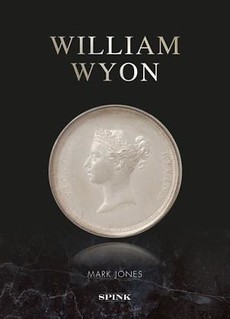 David Fanning writes:
David Fanning writes:
"Mark Jones's Wyon book was published earlier this year and it's fantastic. That said, we haven't reordered after selling the few copies we imported, only because it's both expensive and very heavy (making the cost of importing high). Definitely worth the price, though."
I somehow missed the publication announcement. Glad to know the project came to fruition. -Editor
To read the earlier E-Sylum article, see:
NOTES FROM E-SYLUM READERS: JULY 13, 2025 :
The Wyon Family of Engravers
(https://www.coinbooks.org/v28/esylum_v28n28a09.html)
NUMI V3: AI COIN SORTING PROTOTYPE DEMO
Justin Hinh reported on his recent adventures demoing Numi v3, the latest version of his AI-powered coin sorting robot, at the Colorado Springs Coin Show and Week II of ANA Summer Seminar. -Garrett
Feedback from Coin Collectors & Dealers on the value of an AI Coin-Sorting Robot
After a few weeks of much-needed rest, I thought E-Sylum readers would enjoy hearing the feedback I received about Numi's public prototype debut.
Earlier this month, I attended both the Colorado Springs Coin Club Show and the ANA Summer Seminar as a scholarship recipient. I had one clear mission in mind: to gather honest feedback from the coin community about the utility of an automated AI coin-sorting robot.
At the show, attendees had the opportunity to get their hands on Numi. At Summer Seminar, I took the Advanced Coin Dealing course, taught by Rob Obert from Gold & Coin Exchange and Seth Chandler from Witter Coin. I got to demo Numi to the entire class, and both Rob and Seth were impressed and encouraged me to push Numi further.
The feedback from everyone was eye-opening. I heard everything from expanding beyond wheat cents to Mercury dimes and Buffalo Nickels, to the insight that larger coin shops would require a processing speed of 10,000+ coins per day for Numi to be valuable. People were consistently amazed that it only cost $6 to analyze 10,000 coins. A year ago, it would have been $100.
The top request? Physical sorting capability to automatically separate valuable finds from rejected coins. While Numi doesn't have this feature yet since it's an initial prototype, attendees could see past the current limitations and envision the future Numi promises. Physical sorting is the next planned feature.
The Advanced Coin Dealing course provided me with the most crucial insight for dealers; it's all about velocity and turnover. I specifically sought out this course because if Numi is going to be valuable to dealers, I need to understand how dealers think. It turns out that it's not enough for Numi to unlock additional revenue. It also has to unlock it quickly and profitably enough to justify their time.
Justin Hinh, aka Dansco Dude
Thanks for sharing your reports with us! Great project with many interesting possibilities. -Editor
To read the earlier E-Sylum article, see:
NUMI: AI-POWERED COIN IDENTIFICATION APP
(https://www.coinbooks.org/v26/esylum_v26n47a10.html)
UPDATE: AI-POWERED APP NUMI
(https://www.coinbooks.org/v26/esylum_v26n52a12.html)
REVISITING NUMI
(https://www.coinbooks.org/v27/esylum_v27n16a09.html)
NUMI V2.0 COIN IDENTIFIER & SORTER
(https://www.coinbooks.org/v27/esylum_v27n28a14.html)
NUMI V3: AUTOMATED AI COIN SORTING PROTOTYPE
(https://www.coinbooks.org/v28/esylum_v28n26a15.html)
VOCABULARY TERM: RIBBON LIFT
Here's another entry from Dick Johnson's Encyclopedia of Coin and Medal Terminology. I added an image found online. The ribbon lift is sticking out on the right side of the case. -Editor
Ribbon Lift. A simple ribbon attached to the bottom of a well in a case made for coins or medals. The ribbon is attached to the case and has a short length extending beyond the well. When a coin or medal is placed in the snug-fitting well the ribbon extends beyond it. By pulling up the ribbon lifts the piece from the well.
Some oriental cases have been observed where the ribbon lift has not been fastened to the case at the bottom of the well. Instead the ribbon lies loose, somewhat longer than the width of the well, extending beyond the object on both sides. To lift the item both ends must be grasped and pulled up simultaneously.
Who knew there was a name for those thingys? I should know better - EVERYTHING in this world has been given a name, from aglets to dingleberries to zipper pulls. Naming things has great utility, and mankind has been naming and classifying things it sees since the Garden of Eden. Naming things is essential for communication in specialized fields - every single thing that is made or sold has a name, and Dick's Encyclopedia is a testimony to that for the numismatic field. -Editor
To read the complete entry on the Newman Numismatic Portal, see:
Ribbon Lift
(https://nnp.wustl.edu/library/dictionarydetail/516657)
GEORGE FREDERICK KOLBE (1941-2025)
E-Sylum Feature Writer and American Numismatic Biographies author Pete Smith submitted this article on George Kolbe. Thanks! -Editor
I frequently write technical biographies but don't often include personal remembrances. Here are some biographical facts about George Kolbe that were not in The E-Sylum last week.
 George was born in Yonkers, New York, on September 9, 1941. His parents were George Andrew Kolbe (1906-1984) and Kathleen Louise Golia (1910-1985). He had an older brother Andrew Robert Kolbe (1932-2007) and sister Mary Lou Kolbe Bachman (1934-2001). In the 1930 census, father George was a chauffeur; in 1940, a carpenter.
George was born in Yonkers, New York, on September 9, 1941. His parents were George Andrew Kolbe (1906-1984) and Kathleen Louise Golia (1910-1985). He had an older brother Andrew Robert Kolbe (1932-2007) and sister Mary Lou Kolbe Bachman (1934-2001). In the 1930 census, father George was a chauffeur; in 1940, a carpenter.
The family moved to the Pasadena, California, area in 1943 and settled at 549 N. Holliston Street. For the 1950 Census, the father was listed as a salesman for Monarch Roofing and Insulation Company.
As a teen-ager, George Kolbe delivered papers for the Pasadena Independent. He got his picture in the paper in 1956 as one of their top salesmen.
George graduated from St. Francis High School, a college prep boy's school in Los Angeles. At Loyola University in Los Angeles, he was affiliated with Delta Sigma Phi fraternity.
George married Linda Louise Louiselle (1942-2016) on August 12, 1961. They had three children. Linda died in 2016.
George F. Kolbe joined the American Numismatic association in May, 1966, as member R56210. At the time he was living at 2605 Alvord Lane in Redondo Beach, California. He converted to life membership LM-2316 in May 1979. His mailing address was P.O. Box 178 in Santa Ana, California. His office address was at The Santora Building, Suite 206, 207 North Broadway in Santa Ana, California. By 1980, he had relocated to 23881 Via Fabricante, Suite 511. Mission Viejo, California. By 1986, he was living in Crestline, California.
While at the Santa Ana address, Kolbe issued a cent-sized Patrick Mint token with the inscription GEORGE F. KOLBE / RARE / NUMISMATIC BOOKS / (714) 835-6746 / P.O. BOX 178 / SANTA ANA, CA 92702. The reverse showed one of the Patrick Mint stock dies for a Pine Tree Shilling.
Before going into the numismatic literature business, Kolbe was employed in retail food management.
I attended the 1980 American Numismatic Association convention in Cincinnati. At the convention George F. Kolbe hosted the first meeting of the Numismatic Bibliomania Society. John J. Ford was the entertaining guest speaker. Harry W. Bass stood in the back of the room and heckled.
I believe the attendance was about a hundred people interested in numismatic literature. In creating the Numismatic Bibliomania Society, Kolbe did not create the interest but he created the community where information and passion could be shared.
Kolbe's business thrived as he was in the right place at the right time to serve clients wishing to dispose of libraries and customers with their desire to build libraries.
The Numismatic Bibliomania Society did not have a founding president and Cal Wilson was the first elected president serving 1982 to 1985. George F. Kolbe was elected as a write-in candidate and held the title of president for 1985 to 1987. Linda Kolbe served the NBS as club secretary during 1979 to 1987. George served as editor of The Asylum from 1996 to 1998.
Kolbe contributed a column on numismatic literature to Coin World. In 1984, he presented an ANA Summer Seminar class on A Study of Numismatic Literature.
This was expanded for a second presentation in 1985 and Fascinating World of Numismatic Literature
in 1986.
In 1989, Kolbe participated in publication of Trade Tokens of British and American Booksellers and Bookmakers. He contributed one of the bookseller tokens included in the book. Additional examples of the tokens were included in Kolbe's 1990 44th sale catalog : Selections from the American Numismatic Library of John Weston Adams. Some additional tokens were also available after the sale. I wrote about these tokens for The E-Sylum issue of May 25, 2024.
In commemoration of the June 13, 1998, sale of the Charles Ruby Library, George Frederick Kolbe produced an 11 x 17.5 - inch print for distribution to clients. This is listed as item AO-125 on page 252 of The Secret History of the First U. S. Mint. The image is an oval copy of Washington Inspecting the First Money Coined by the United States. I am fortunate to have copy 1 of 125 issued by Kolbe although my copy differs in size from the description in the book. I understand there may be as many as 124 other examples of copy #1.
The mailer included a smaller 8.5 x 11 - inch holiday greeting for 1999. This included the message You Are No, 1
Kolbe contributed The Tale of the Tape
to the January 2014 issue of The Numismatist. His article received an honorable mention
from the ANA. Another article, Burned by Burnie
appeared in the March 2020 issue.
George died in Crestline, California, on July 12, 2025.
Dennis Tucker adds:
 "George F. Kolbe was one of the first numismatic specialists I consulted after I joined Whitman Publishing in 2004. Three months after I was hired as publisher we were wrapping up the manuscript of the 59th edition of the Red Book. A few of the final task areas: review Scott Rubin's current "Top 250" list of auction records; double-check the Stella mintages using the latest research by Saul Teichman; and "Send Red Book prices to George Kolbe for his review." As the nation's preeminent dealer in numismatic books, George was our most important contributor to the "Red Book as a Collectible" section.
"George F. Kolbe was one of the first numismatic specialists I consulted after I joined Whitman Publishing in 2004. Three months after I was hired as publisher we were wrapping up the manuscript of the 59th edition of the Red Book. A few of the final task areas: review Scott Rubin's current "Top 250" list of auction records; double-check the Stella mintages using the latest research by Saul Teichman; and "Send Red Book prices to George Kolbe for his review." As the nation's preeminent dealer in numismatic books, George was our most important contributor to the "Red Book as a Collectible" section.
Vintage editions of the Red Book and Blue Book were only a fraction of the volume of his rare-book sales, of course, but his specialized knowledge of the market was just what we needed. George was an active consultant for nearly my entire twenty years at Whitman, and I was grateful to have his expertise to rely on. He also helped with information in Frank J. Colletti's Guide Book of the Official Red Book of United States Coins and other projects. You'll find George F. Kolbe cited in many Whitman Publishing books --- a pleasant and proper place for his memory to live on."
To read the earlier E-Sylum article, see:
GEORGE FREDERICK KOLBE (1941–2025)
(https://www.coinbooks.org/v28/esylum_v28n28a02.html)
THE BOOK BAZARRE
PAUL HOLLIS NOMINATED FOR U.S. MINT DIRECTOR
The wait is over - the White House has nominated a new Director of the U.S. Mint. -Editor
 When he was a little kid, Paul Hollis said his grandmother gave him a Peace dollar from the Great Depression, sparking a lifelong love of coins.
When he was a little kid, Paul Hollis said his grandmother gave him a Peace dollar from the Great Depression, sparking a lifelong love of coins.
On Thursday, President Donald Trump nominated Hollis, an elected member of the Louisiana Board of Secondary and Elementary Education and a former state representative from St. Tammany Parish, to run the U.S. Mint, the government agency in charge of making the nation's coins.
The nomination now heads to the U.S. Senate, which will have a confirmation hearing. Hollis, of Mandeville, said he plans to carry the same Peace Dollar in his pocket to that hearing. The Peace Dollar is a dollar coin first made in 1921 to commemorate the end of World War I.
"I'm thrilled about it," Hollis, a coin collector, said of his nomination. As part of the process, he spoke with treasury officials — the U.S. Mint is a bureau in the department of the U.S. Treasury — and after the nomination received a call of congratulations from Trump and House Speaker Mike Johnson, who he said had recommended him to Trump. Hollis and Johnson had served in the state Legislature together.
Hollis, a Republican, served three terms in the state House of Representatives between 2012 and 2024. In 2023 he won BESE's 1st District seat, which covers St. Tammany Parish and parts of Jefferson and Orleans parishes.
"I love Louisiana, but the calling is to serve in Washington," Hollis said.
Hollis said he would be the first director of the U.S. Mint, which was established in 1792, from Louisiana and the only numismatist — a term for coin collector that he admits can be difficult to pronounce.
"It's been a passion that I've had for my entire life," he said. "My brothers wondered, why would you sit there and stare at the coin? But I loved it."
After graduating from Louisiana State University in 1994 with a degree in political science, he joined Blanchard and Company, a rare coin firm based in New Orleans. Then in 2003, he started his own firm, Paul Hollis Rare Coins, selling collectibles on home shopping channels. He wrote a book called the American Numismatist about the nation's history and coins.
After years in politics, he said, this nomination is "the cherry on top of the sundae."
As director, Hollis would oversee plans to phase out the penny, he said. He would also be involved in the U.S. Mint's celebration of the 250th anniversary of the nation.
"They're tangible links to our nation's history," he said of coins. He pointed to how John F. Kennedy was added to the half-dollar after he was assassinated, and how Abraham Lincoln was put on the penny in 1909 to celebrate the 100th anniversary of his birthday. "Every coin — there's a reason for it."
He intends to keep his residence in Mandeville, in addition to a residence in Washington, D.C., he said. He is married with two children, a 12-year-old son and a 21-year-old daughter.
Hollis' nomination will now be heard by the U.S. Senate Committee on Banking, Housing and Urban Affairs and, if approved, it would then go to a vote by the full Senate.
To read the complete article, see:
Trump nominates Paul Hollis, BESE member and former St. Tammany legislator, to run U.S. Mint
(https://www.nola.com/news/politics/national_politics/paul-hollis-nominated-to-run-us-mint/article_520ecffa-bf02-4f2f-94a6-6bb4840e2edd.html)
Here's an excerpt from another local New Orleans article. -Editor
Hollis will have to resign his state school board seat to take the Mint director job, but he isn't sure when he will step down yet. His departure will likely be followed by the interim appointment of a new school board member by Gov. Jeff Landry and then a special election to fill the seat permanently.
Hollis said he reached out to President Donald Trump and U.S. House Speaker Mike Johnson, R-Benton, ahead of the 2024 election to express interest in becoming the Mint director if Trump won a second term. Johnson and Hollis served in the Louisiana House together and are friends, Hollis said.
Assuming he receives Senate confirmation, Hollis said he is most excited about helping the U.S. government celebrate the 250th anniversary of the Declaration of Independence next year, which will come with a new batch of coins.
He will also assist with the phasing out of the penny. The Mint is expected to stop producing one-cent coins in early 2026.
Hollis said his favorite coin is the one that launched his interest in numismatics as a child. When he was seven, his grandmother gave him a $2.50 Indian Gold coin made in New Orleans during the Great Depression.
I think the reporter is mixing up the quarter eagle with the Peace Dollar mentioned in other articles. -Editor
To read the complete article, see:
Trump picks Louisiana state school board member, coin aficionado to run U.S. Mint
(https://lailluminator.com/2025/07/17/trump-picks-louisiana-state-school-board-member-coin-aficionado-to-run-u-s-mint/)
John Feigenbaum published this Greyheet note on the appointment. -Editor
The role is vital to those of us in the coin trade and the nominee couldn't be more welcome, in my opinion. Paul is a true friend of the community, life-long coin collector, and some time professional numismatist. The majority of his life's work has been dedicated to service in his and the Louisiana community.
I already had the pleasure of speaking to Paul and his enthusiasm for coin collecting is evident the moment he opens his mouth. He's full of great ideas for extending the Mint's role to both collectors, and of course for smarter ways to distribute coinage.
Paul has promised to join us soon for a podcast conversation, so stay tuned for this and other updates.
To read the complete article, see:
White House Nominates Paul Hollis as next Mint Directo
(https://www.greysheet.com/news/story/white-house-nominates-paul-hollis-as-next-mint-director)
NUMISMAGRAM MEDAL SELECTIONS: JULY 20, 2025
Numismagram's Jeremy Bostwick sent along these five medals from his most recent upload of new Americana-themed material to his site. For all of the new items, please visit https://www.numismagram.com/inventory. -Garrett
103250 | FRANCE. National Convention bell metal Medal. Issued 1792/Year 1 of the Republic (41mm, 41.10 g, 12h). By André Galle in Lyon. LIBERTE FRANÇOISE / L'AN I DE LA R F, head of Liberty left, with hair flowing freely and with pole surmounted by Phrygian cap over far shoulder // A LA / CONVENTION / NATIONALE / PAR LES / ARTISTES REUNIS / DE LYON / PUR METAL / DE CLOCHE / FRAPPE EN / MDCCXCII in ten lines; all within garlanded oak wreath. Edge: Plain. Mazard 318a; Guilloteau 338; Bramsen 190b. Choice Mint State. Dark olive-brown surfaces, with some alluring brilliance; a minor reverse planchet chip near the rim is noted for completeness, but is rather easily overlooked given the exceptional quality of preservation and the overall superior nature of the planchet. On account of the composition (melted down bells), the level of craftsmanship of surviving examples tends to be on the poorer side. A popular and attractive type that clearly drew great inspiration from the Libertas Americana medal issued a decade prior, and paralleled the contemporary American coinage during the mint's initial outputs of "flowing hair" designs. $1,095.
To read the complete item description, see:
103250 | FRANCE. National Convention bell metal Medal.
(https://www.numismagram.com/product-page/103250)
103186 | ITALY & UNITED STATES. Christopher Columbus/"Civilization" white metal Medal. Issued 1892 for the 400th anniversary of the discovery of America (59mm, 84.70 g, 12h). By Ludovico Pogliaghi & Angelo Cappuccio for Stefano Johnson in Milano. Central medallion reading CRISTOFORO COLOMBO and with robed bust facing slightly left; around, native princess and Columbia clasping outstretched arms; above, globe focused upon the Western hemisphere; below, eagle perched slightly left, head upturned right, with wings spread; all over wreath composed of palm fronds and laurel branches // The fruits of Columbus's first voyage: Winged personification of Civilization facing slightly left, head right, surrounded by Genii representing Education, Commerce, and Industry; to lower right, native chief, maiden, and two warriors crouching defensively; at a distance, coastline with the U.S. Capitol before rising sun; around, border comprised of alternating stars and state shields. Edge: Plain. Eglit 107; Starlust ST-eg-107wm; Rulau B8. Choice Mint State. Highly brilliant and lustrous in the fields, with a great frosted nature and intense relief elsewhere; a few scattered light marks are noted for completeness, and prevent an even higher designation. Ex Ed Kuszmar Columbian Exposition Collection. $545.
To read the complete item description, see:
103186 | ITALY & UNITED STATES. Christopher Columbus/"Civilization" white metal Medal.
(https://www.numismagram.com/product-page/103186)
103258 | GERMANY & UNITED STATES. Christopher Columbus/"The Journey" bronze Medal. Issued 1893 for the 400th anniversary of the discovery of America (50mm, 12h). By Mayer & Wilhelm in Stuttgart. CHRISTOPHER COLOMBUS / BORN 1456 DIED 1506, half-length bust of Columbus facing slightly left, holding charts; all within wreath / SOUVENIR WORLD'S COLUMBIAN EXPOSITION, CHICAGO, U.S.A. 1892-1893, two female allegories (Italia and America) to right, one seated and one standing, pointing at a distance to left over the expo ground; Nina, Pinta, and Santa Maria on horizon to left with rising sun; above, eagle with wings spread over banner and with olive branch and arrows in talons; in two lines in exergue, 1492–1892 / IV. CENTENNIAL. Edge: Plain. Eglit 55; Starlust ST-eg-55; Rulau B6A; cf. Bernd Kaiser V, 128 (white metal). NGC MS-65. Glossy red-brown surfaces with alluring brillance. $435. "The Journey" medal was produced commemorating the quatercentenary in Germany by the Stuttgart-based manufacturer, Mayer & Wilhelm.
To read the complete item description, see:
103258 | GERMANY & UNITED STATES. Christopher Columbus/"The Journey" bronze Medal.
(https://www.numismagram.com/product-page/103258)
102771 | UNITED STATES & GREAT BRITAIN. Christopher Columbus/Columbian Expo bronze Award Medal. Issued 1896 for the 400th anniversary of the discovery of America and as the official prize [awarded John Laing & Sons] for the 1893 Columbian Expo held in Chicago (76mm, 206.60 g, 12h). By Augustus Saint-Gaudens & Charles Barber, and struck by Scovill Manufacturing Co. in Waterbury. Columbus advancing facing slightly left onto land, extending arms and with head lifted toward the heavens; to upper right, arms of Spain above CHRISTOPHER / COLVMBVS / OCT XII / MCCCCXCII in four lines // Two nude female genii seated back-to-back, one trumpeting, the other inscribing globe between them; garlanded torch to left and right; below, Santa Maria left; all around central plaque reading WORLD'S COLUMBIAN EXPOSITION / IN COMMEMORATION OF THE / FOUR HUNDREDTH ANNIVERSARY / OF THE LANDING OF COLUMBUS / MDCCCXCII • MDCCCLCIII / TO [JOHN LAING & SONS] in six lines. Edge: A few light scratches in one spot, otherwise plain. Eglit 90; Starlust ST-eg-90; Rulau X3. Gem Mint State. Rich chocolate brown surfaces, with great luster remaining. Includes original aluminum presentation box of issue. Compare to a similar, though slightly less attractive specimen in a PCGS MS-66 Brown holder, that realized a total of $1,200 [!] in the Stack's Bowers June Showcase auction (24 June 2025), lot 1170. Listed in the "100 Greatest American Medals and Tokens" as #53. $765.
To read the complete item description, see:
102771 | UNITED STATES & GREAT BRITAIN. Christopher Columbus/Columbian Expo bronze Award Medal.
(https://www.numismagram.com/product-page/102771)
103209 | UNITED STATES. Alaska–Yukon–Pacific Exposition bronze award Medal. Issued 1909. Presented at the expo for the "bronze" award (76mm, 175.86 g, 12h). By Frederick Ziegler for Gorham Manufacturing Co.. – ALASKA • YUKON • PACIFIC • EXPOSITION – / 1909 • SEATTLE • 1909, Columbia seated facing, holding branch and plaque with bust of George Washington, and with foot set upon cornucopia; Native American in canoe to lower left, two prospectors to right; steamship and rising sun in background // Ornate plaque inscribed BRONZE MEDAL and with the lower panel left blank for engraving; all within floral wreath. Edge: Plain. Choice Mint State. Rich brown surfaces. $495.
To read the complete item description, see:
103209 | UNITED STATES. Alaska–Yukon–Pacific Exposition bronze award Medal.
(https://www.numismagram.com/product-page/103209)
HERITAGE: CALIFORNIA FRACTIONAL GOLD SHOWCASE
Heritage Auctions will be hosting their California Fractional Gold U.S. Coins Showcase auction on July 21, 2025. Select items are discussed below. -Garrett
Undated 25C Liberty Round 25 Cents, BG-201, High R.7, -- Bent -- PCGS Genuine. Unc Details. Ex: Jack Totheroh Collection.
To read the complete item description, see:
Undated 25C Liberty Round 25 Cents, BG-201, High R.7, -- Bent -- PCGS Genuine. Unc Details.
(https://coins.ha.com/itm/california-fractional-gold/undated-25c-liberty-round-25-cents-bg-201-high-r7-bent-pcgs-genuine-unc-details-ex-jack-totheroh-collection/a/60468-52008.s)
Undated 25C Liberty Round 25 Cents, BG-207, High R.5, -- Damaged -- PCGS Genuine. AU Details.
To read the complete item description, see:
Undated 25C Liberty Round 25 Cents, BG-207, High R.5, -- Damaged -- PCGS Genuine. AU Details.
(https://coins.ha.com/itm/california-fractional-gold/undated-25c-liberty-round-25-cents-bg-207-high-r5-damaged-pcgs-genuine-au-details-pcgs-10392-/a/60468-52011.s)
1853 50C Liberty Octagonal 50 Cents, BG-304, Low R.5, -- Harshly Cleaned -- PCGS Genuine. AU Details.
To read the complete item description, see:
1853 50C Liberty Octagonal 50 Cents, BG-304, Low R.5, -- Harshly Cleaned -- PCGS Genuine. AU Details.
(https://coins.ha.com/itm/california-fractional-gold/1853-50c-liberty-octagonal-50-cents-bg-304-low-r5-harshly-cleaned-pcgs-genuine-au-details/a/60468-52026.s)
1854 50C Liberty Round 50 Cents, BG-436, R.6, MS62 NGC. Thick reverse letters, usual late die state. Defiant eagle reverse without scroll. The surfaces on this distinctively designed half dollar show bright yellow color with deep reddish accents in the fields. A well-detailed example of this rare Period One half dollar engraved by "Unknown Maker B."
Ex: Long Beach Signature (Heritage, 2/2007), lot 6238.
To read the complete item description, see:
1854 50C Liberty Round 50 Cents, BG-436, R.6, MS62 NGC.
(https://coins.ha.com/itm/california-fractional-gold/1854-50c-liberty-round-50-cents-bg-436-r6-ms62-ngc-thick-reverse-letters-usual-late-die-state-defiant-eagle-re/a/60468-52039.s)
1870 25C Liberty Octagonal 25 Cents, BG-713, R.4, MS67 PCGS. PCGS Population: (4/0 and 0/0+).
To read the complete item description, see:
1870 25C Liberty Octagonal 25 Cents, BG-713, R.4, MS67 PCGS.
(https://coins.ha.com/itm/california-fractional-gold/1870-25c-liberty-octagonal-25-cents-bg-713-r4-ms67-pcgs-pcgs-population-4-0-and-0-0-pcgs-10540-/a/60468-52064.s)
1871 25C Liberty Round 25 Cents, BG-810, Low R.7, -- Damaged -- PCGS Genuine. AU Details.
To read the complete item description, see:
1871 25C Liberty Round 25 Cents, BG-810, Low R.7, -- Damaged -- PCGS Genuine. AU Details.
(https://coins.ha.com/itm/california-fractional-gold/1871-25c-liberty-round-25-cents-bg-810-low-r7-damaged-pcgs-genuine-au-details-pcgs-10671-/a/60468-52111.s)
1876 25C Indian Round 25 Cents, BG-879, R.4, MS65 Prooflike PCGS. PCGS Population: (2/0 and 0/0+).
To read the complete item description, see:
1876 25C Indian Round 25 Cents, BG-879, R.4, MS65 Prooflike PCGS.
(https://coins.ha.com/itm/california-fractional-gold/1876-25c-indian-round-25-cents-bg-879-r4-ms65-prooflike-pcgs-pcgs-population-2-0-and-0-0-pcgs-771787-/a/60468-52148.s)
WAYNE'S NUMISMATIC DIARY: JULY 20, 2025
Time sure flies. Tuesday was the monthly dinner meeting of my Northern Virginia numismatic social group, Nummis Nova. Mike Packard was our host, and he chose Maggiano's Little Italy restaurant in Tyson's. The food and wine are always great, and this was where we held our second meeting and the first that many of our regular members attended.
I arrived a little early and found Mike Markowitz, Eric Schena and Dave Schenkman already congregated at the bar. It was around 6 o'clock and our reservation wasn't until 6:45. Tom Kays joined us while we passed around some of the coins and books we'd brought. Eric showed off a great non-numismatic book, a pioneering history of mining in Virginia.
I'll let Tom Kays start us off with one of his trademark takes on the evening.
Tom's Take
Nummis Nova dines again in the Oh, So Fashionable
Tysons Galleria at Maggiano's Little Italy. Clockwise from center, on a first name basis by now, are JK,
Mike P., Tom (behind camera), Wayne, Erik, Steve, Roger, Julian, Robert, Mike M., Dave, Eric, and Jon. Walking the shopping mall before dinner one is awash with one-named designer retailers (not outlets) including Cartier, Chanel, Dior, Gucci, Montblanc, Prada, Rolex, and Versace. In what other mall would you find tuxedoed security escorts, Foreign Currency Exchanges, Day Spas, and the Ritz-Carlton catering to wealthy European and Middle Eastern visitors come for a day of retail splurging? This is the dinner spot where the experimental, second Nummis Nova meeting convened, twenty years ago and where some of us first met the three first Nummis Nova diners who congregated a month prior, wondering if random coin collectors, dealers, and numismatic book authors would share polite dinner conversation and have anything newsworthy to say about the hobby.
Befitting our fashionable surroundings, an exclusive ascension to the crown fashion show
of tiara selections for young Queen Victoria were on display at the bar even before dinner, in a dizzying array of rare and heavy gold coronation and personal medals, (circa 1837-1841). On the reverse of the last medal Victoria finally settles on her choice of headgear, not just any old princess's tiara, but the Imperial State Crown, with assessor scepters as seen at Westminster. A wise choice back then for dinner functions with foreign dignitaries, but now British imperialism is out of favor, and so her crown remains locked away in a garret in the Tower of London. Such are the seasons of fashion.
Also seen at table were many unusual items including: a Spanish colonial one real of Charles IIII with 19th century counterstamp from Nortones Cigar Store – Richmond, VA; a selection of beautifully toned, uncirculated coins including an 1886 Morgan dollar, 1863 and 1922 Cents; a pair of bronze medals from Belgium including La Maison de Surete Civile et Militaire a Anvers of 1856, and Notre-Dame a Anvers of 1845; a 25 Cent Wisconisco Canal and Coal Company Scrip of 1838, a $1/$10/$1000 advertising note from the Shinplaster Bank
(from ten to thousand dollars in shin plasters executed in the best style on demand) which was a lithography enterprise willing to print unregulated notes for wildcat banks; an 1826 $5 advertising scrip from Baltimore for Hobson & Witherspoon, Merchant Tailors; and more numismatic items, pictured under soft, restaurant mood lighting and within their protective plastic cases below:


Roman Empire (457 – 474 AD) Gold Semissis of Leo I from Thessaloniki with Victory inscribing a shield;
A small case of wonderment
appeared at dinner, having more odds than ends, of recent acquisitions. Sometimes historic items appear so underwhelming at first glance they need descriptive tags for anyone to appreciate them. Here you see a mélange of stampees,
guillotines, ancients, counterfeits, errors, and items dug up after centuries in the ground, along with genuine coins, medals, and tokens spanning more than two millennia.
Highlights include an unusual 1871 Robert E. Lee portrait in white medal by Rudolph Philipp Laubenheimer (1833 - 1905), two bits dug on Cumberland Island, Georgia, coin buttons of Ferdinand VII and Isabella II bearing resemblances to gold and silver coins, an Anchor
on a Santo Domingo four maravedis host from the 1550s, a 1713 Peace of Utrecht Medal showing the English fleet at the end of hostilities in the War of Spanish Succession, one of Syd Martin's down a rabbit hole
obscure tokens for Tobago stamped on a Birmingham counterfeit host in imitation of a French Colonial copper sou marque
(These are of local interest as many similar were found at French Army campsites after they left Saint Dominque under Napoleon's response to slave revolts in Haiti.
The French troops recuperated from tropical diseases near Norfolk, Virginia in 1800 where dug TBo
tokens posed a mystery), an image of Roma/Roman citizens voting under Publius Licinius Nerva (the Moneyer) in the Ponticulus of the Comitia on a denarius of 16 asses value, along with a silver Antoninianus from Lugdunum, gold half guineas from nearby at the Tower Mint, King George III's incuse ghost facing the wrong way, and a Thomas Jefferson birth year half-a-Spanish-milled dollar. Pretty mundane stuff for the Nummis Nova crowd, yet I hope in the running for this month's Weirdness Prize
at Nummis Nova's Show and Tell.


Case of Wondermentclose-up – Medal in Tribute to the
Memory of Gen. Robert E Lee – 1871 - by Rudolph Philipp Laubenheimer


Case of Wondermentclose-up –Voting circa 106 BC -
Roma/Roman citizens voting under Publius Licinius Nerva (the Moneyer)
in the Ponticulus of the Comitia on a denarius of 16 asses value.
As always, new numismatic literature in print, or about to be in print, or with amazing inscriptions circulated including Notes on the Establishment of a Monetary Unit by Thomas Jefferson personally inscribed to Wayne with appreciation and admiration
with forward by Judy Shelton; The Moby Dick Doubloon by Mike Markowitz; The Evolution of U.S. Minting Technology (1793-1840) by Craig Sholley; Niall Ferguson's The Ascent of Money – A Financial History of the World; Striking Gold in Alaska – Making Tokens from Placer Gold by Dick Hanscom 8th Edition; and the latest C4 Newsletter (Many of us have it in our mailboxes but have not yet read it).
Nummis Nova brings to coin dinners what Neiman-Marcus, Saks Fifth Avenue, and Salvatore Ferragamo bring to the Tyson's Galleria Mall which is boutique browsing of unusual and high-end merchandise all under one roof.
Five Books and a Coin
Last month I didn't bring a single numismatic book, but I made up for it this time, starting with two titles relating to the U.S. Mint.
 The first is a nice reprint of Thomas Jefferson's Notes on the Establishment of a Money Unit and of a Coinage for the United States by economist Judy Shelton. If her name rings a bell, she was nominated by President Trump for the Federal Reserve Board in 2020 and 2021.
I'd bought it online from a used book dealer who noted it was inscribed. When it arrived, I saw that it was inscribed "To Wayne". Wayne who, I don't know. But it was a nice coincidence.
The first is a nice reprint of Thomas Jefferson's Notes on the Establishment of a Money Unit and of a Coinage for the United States by economist Judy Shelton. If her name rings a bell, she was nominated by President Trump for the Federal Reserve Board in 2020 and 2021.
I'd bought it online from a used book dealer who noted it was inscribed. When it arrived, I saw that it was inscribed "To Wayne". Wayne who, I don't know. But it was a nice coincidence.
Here are a couple sample pages. The book consists of a six-page Foreword by Shelton followed by photos of each page of Jefferson's manuscript with a transcription on the facing page.
The second is a hot-off-the-presses copy of a new book by Craig Sholley, The Evolution of U.S. Minting Technology. It just arrived this week and I haven't had a chance to read it yet. Here's my poorly-focused photo of a couple sample pages.
Third was a softcover version of the 2011 book Quarterama about the designs for the 50 States and National Parks quarters. It was recently discussed in a David Lisot video article. The bookseller did a horrible packing job - it was basically tossed into a plastic bag with no cardboard or other packing material, and arrived bent. Glad it's just a filler for my library.
To read the earlier E-Sylum articles, see:
NEW BOOK: QUARTERAMA: IDEAS AND DESIGNS OF AMERICA'S STATE QUARTERS
(https://www.coinbooks.org/esylum_v16n02a07.html)
VIDEO: AMERICA'S STATE QUARTERS
(https://www.coinbooks.org/v28/esylum_v28n25a07.html)
The remaining two books were the new 8th edition of Dick Hanscomb's Striking Gold in Alaska (more elsewhere in this issue), and a copy of Supernote that Steve Bishop brought as a giveaway. I quickly snagged it and look forward to reading it.
To read the earlier E-Sylum article, see:
NEW BOOK: SUPERNOTE
(https://www.coinbooks.org/v28/esylum_v28n17a05.html)
Here are some better images of my newest error coin, an off-center 1920 Mercury dime. Purchased online from E-Sylum supporter Jon Sullivan. Everyone at the dinner liked it.
I'll finish out with some of my other photos for the evening.

Roger Burdette reads Mike Markowitz's Top Ten Medieval Coins
presentation while Julian Leidman examines a coin
Here are some additional notes and images courtesy our attendees.
Queen Victoria Gold Medals
Here are Dave Schenkman's images and notes on some of the amazing gold medals he brought along.
This 36mm gold 1837 medal for the accession of Queen Victoria is listed by Brown as number 1764. He only lists in silver and bronze, but mentions that it was possibly struck in gold also. The engraver was William Wyon.
This is the official in gold for the 1838 coronation of Queen Victoria. The engraver was Benedetto Pistrucci, and medals were struck in gold, silver, and bronze.
This is listed in Laurence Brown's tome as number 1991. He estimates that about twenty were struck. It is 45mm and weighs 42.2 grams. The engraver was William Wyon.
Steve's Beauties
Steve Bishop sent these photos of the coins he shared at dinner. Thanks.
Norton's Cigar Store, Richmond, VA
 John Kraljevich writes:
John Kraljevich writes:
"Here is a picture of the Norton's Cigar Store mark and a couple of newspaper ads from 1855. Norton was one of the great Virginia tobacco families -- John Norton of the same mercantile family was Virginia's agent in London when it was time to ship the 1773 Virginia halfpence"
27th Regiment U.S. Colored Infantry
John adds:
 "The 27th USCT token is listed as Schenkman US-27-25B. How many times do you get to bring something for show and tell to a dinner with the guy who wrote the book? The 27th was an important regiment, present at Petersburg, the Battle of the Crater, and more. Among its members were white officer Lt. Col. John W. Donellan, who went on to sign National Bank notes as cashier of the Commercial National Bank of Salt Lake City, and formerly enslaved Pvt. Paul Sandridge, who happened to be Lawrence Fishburne's great-great grandfather.
"The 27th USCT token is listed as Schenkman US-27-25B. How many times do you get to bring something for show and tell to a dinner with the guy who wrote the book? The 27th was an important regiment, present at Petersburg, the Battle of the Crater, and more. Among its members were white officer Lt. Col. John W. Donellan, who went on to sign National Bank notes as cashier of the Commercial National Bank of Salt Lake City, and formerly enslaved Pvt. Paul Sandridge, who happened to be Lawrence Fishburne's great-great grandfather.
"When Sandridge was hospitalized at the L'Ouverture Hospital (two blocks from my house in Alexandria), he was among the signers of a petition demanding equal burial rights for African-American veterans. The petition succeeded. https://gravestonestories.com/timeline/african-american-soldiers-protest-burial-practices/"
Wow - what great history. This is what is so compelling about numismatic research. One never knows where the trail might lead. Great pieces.
It was another wonderful evening of numismatics and numismatic fellowship. I'm already looking forward to next month.
EXETER MUSEUM'S KING ALFRED THE GREAT COIN
This BBC News report describes a museum's acquisition of a rare King Alfred the Great coin. -Editor
A museum in Exeter has said a rare Anglo-Saxon coin - one of only three known to exist and made in the city more than 1,100 years ago - is "finally coming home".
The inscription on the silver penny is believed to be the earliest known use of the name Exeter.
According to the Royal Albert Memorial Museum (RAMM), which bought the penny for an undisclosed sum, it was made in Exeter in about 895-899 on the orders of King Alfred the Great.
The coin had been in the Dr Irving Schneider Collection in America since 1989, but the collection came up for auction in Zurich in May, allowing the museum a chance to buy it.
RAMM's assistant curator Tom Cadbury said: "This little coin is an incredibly important piece of Exeter's history.
"It was made 1,130 years ago making it the earliest known use of the name Exeter.
"Only three of these coins have ever been found and the museum has been aware of this one's existence since 1868.
"It's incredible that it's finally coming home."
To read the complete article, see:
Museum buys rare King Alfred the Great coin
(https://www.bbc.com/news/articles/ckglp85wlkno)
CURIOUS NUMISMATIC JUDAICA
Tsadik Kaplan writes:
"I check in to E-Sylum from time to time, as I collect medals (among other things). I write a monthly column in The Jewish Press and I thought the topic of this month's issue may be of interest to your readers."
Thanks. Can anyone provide additional information about these pieces? -Editor
Occasionally, when I'm introduced to someone, and the person introducing me says, He writes a column in The Jewish Press about antique Judaica,
I receive the response That's you?! How do you know so much?
I in turn state that since I've been collecting and appraising Judaica for almost 30 years, the vast majority of what I encounter is something I've seen before. Sure, every now and then I might be shown a piece which needs a bit of research, but I've just about seen it all, including rare and unique pieces that are filed away in my brain from my library of auction catalogs and museum publications.
And yet, in my personal collection, there are three examples that have left me baffled. I am not embarrassed to reveal this; on the contrary, it is fascinating – albeit frustratingly so. I have consulted numerous experts in a variety of fields for their thoughts, and thus far have received little insight. Here they are for your enjoyment (and perhaps your help).
First up, this coin-like disc is made of a thin piece of stamped tin; it measures 22 millimeters in diameter, which is about the size of a nickel. In Hebrew it states Western Wall / ZYAA
on one side, and the reverse side is blank. While the bottom four letters are almost assuredly an acronym, although the lower half of the first letter is very worn, by process of elimination I assume that it is the letter zayin, so the letters seen are of zayin, yud, ayin, and aleph, which stands for zechuto yagen aleinu amen (may his virtues protect us, amen). This is a blessing for the deceased that is added after the names of righteous people.
Coin-like pieces such as this are classified as tokens. A token is not an official government-issued coin but privately made, and is used as a substitute for money or for other purposes like advertising.
In late-19th and early-20th century Jerusalem, thin brass tokens with the Hebrew letters chet and kuf were made; these letters stand for Chevra Kadisha
(Burial Society). These tokens were meant to be distributed to the poor; when carrying coffins, for beggars in the Mount of Olives cemetery, or for professional mourners
– those who would participate in a minyan when saying the Kaddish during a burial. Once a quantity of tokens was accumulated, they could be exchanged for the legal tender at that time – Turkish money – at a local Jewish community office.
These Jerusalem tokens are not rare and are readily available for purchase by collectors for about $25. Is my token with the Kotel Ha Ma'aravi and the (presumed) acronym of zechuto yagen aleinu amen on it from Ottoman Empire-controlled Israel? Israel was not devastated by the destruction and loss World War II brought to the Jewish settlements of Europe, so if this was issued there, other examples would be known, especially among collectors and institutions, which they are not.
Aside from that, I acquired this from a coin dealer in France, who found it in a junk lot
of various European coins and tokens, so in all likelihood, this was issued in Europe. Since the phrase on the token is associated with the departed, was it used in a similar fashion for the poor relating to burials? If so, why have Western Wall
on it? Was it to express the longing of leaving exile and returning to the Land of Israel? Or is there a more substantial reason which is related to the purpose this token served? Was it used for another form of charity? When was it made? Where in Europe is it from?
 The next two puzzling pieces are solid brass, each measuring 2.5 inches by 1.3 inches. I purchased both of them from one of my metal-detector enthusiast contacts in Ukraine about 15 years ago. Unlike the aforementioned small, thin token made of stamped tin, these brass examples are large, thick and heavy, and well-cast with much detail seen.
The next two puzzling pieces are solid brass, each measuring 2.5 inches by 1.3 inches. I purchased both of them from one of my metal-detector enthusiast contacts in Ukraine about 15 years ago. Unlike the aforementioned small, thin token made of stamped tin, these brass examples are large, thick and heavy, and well-cast with much detail seen.
One side shows a pair of lions flanking a representation of the Ten Commandments, topped by a crown. A crown above a pair of lions flanking the Ten Commandments is commonly found on all kinds of Judaica, referred to as a Crown of Torah
above Lions of Judah.
On the Torah ark curtain of your local synagogue, you will see this imagery.
 The reverse side of the first piece shown depicts the astrological sign for the Hebrew month of Cheshvan, which is Scorpio. The word Cheshvan is at bottom; however, it is spelled in an uncommon way, which is with two of the letter vav instead of what is usually seen, which is one vav. This is not troublesome, but what does rankle me is that the final Hebrew letter in Cheshvan was not done properly: It should look like a nun sofit, but it appears as a chaf sofit. Why go through the trouble to make an intricate design in wax, sand-cast it to produce this medallion, and not have the Hebrew lettering be perfect? Was this executed by someone not familiar with Hebrew?
The reverse side of the first piece shown depicts the astrological sign for the Hebrew month of Cheshvan, which is Scorpio. The word Cheshvan is at bottom; however, it is spelled in an uncommon way, which is with two of the letter vav instead of what is usually seen, which is one vav. This is not troublesome, but what does rankle me is that the final Hebrew letter in Cheshvan was not done properly: It should look like a nun sofit, but it appears as a chaf sofit. Why go through the trouble to make an intricate design in wax, sand-cast it to produce this medallion, and not have the Hebrew lettering be perfect? Was this executed by someone not familiar with Hebrew?
The reverse side of the second piece has the verse Come let us sing to the L-rd, let us make a noise to the rock of His salvation
(Psalms 25:1), which is recited at the start of prayers in the synagogue on Friday night. For this example, all the Hebrew lettering is competently done.
Each of these medallions has integral loops, indicating they were meant to hang from someone, or something. In my opinion, they are much too heavy to wear around the neck. But then to hang from where – on a loop for your belt? What is the purpose of an astrological sign for one, and a well-known verse from Psalms on the other? As an amulet of sorts?
For the enormous Christian population in Galicia (which includes much of present-day Ukraine), mass quantities of metal pendants featuring figures and text related to that religion were produced from the 18th century onward; I can't help but think that these medallions were an attempt to financially capitalize on that, for the substantial Jewish population of Galicia, which may explain the ineptitude in Cheshvan,
as it could have been produced by a gentile.
How old are these? The styling of the lions, tablets, and crown indicate an era of manufacture of somewhere between 1870 and 1910. There is a rich buildup of patina that suggests they were indeed buried in the ground for many decades, as the encrustation of the dirt appears natural, as do the smooth surfaces which indicate wear. However, patina can be faked…
Since I have not been able to locate similar examples to these medallions, nor to determine any sort of feasible purpose for them, I cannot dismiss the possibility that they are not authentic antiques, but instead are fantasy pieces,
which is a type of forgery. Typically, a fantasy piece is a hodgepodge of two or more styles of what are found on old items which have been combined into a new item that never existed – except in the mind of the person making it – and are created for the express purpose of fooling an enthusiastic buyer (me?).
Will this public airing of hopelessness lead to any definitive answers? Only time will tell!
To read the online article, see:
No, I Don't Know Everything
(https://www.jewishpress.com/sections/features/features-on-jewish-world/no-i-dont-know-everything/2025/07/04/)
1721 PIRATE TREASURE DISCOVERED
After more than 16 years of research, archaeologists believe they have now found the shipwreck of the Nossa Senhora do Cabo, a Portugese ship that carried an estimated $138 million, including many coins and silver and gold bars. -Garrett
In the waters off Madagascar's northeast coast, archaeologists say they have uncovered the final resting place of a ship plundered in one of history's most dramatic pirate raids. The wreck, they believe, is that of the Nossa Senhora do Cabo—a Portuguese vessel overtaken in 1721 by the infamous pirate Olivier The Buzzard
Levasseur.
More than three centuries after its capture, the remnants of the ship lie beneath the waves near Nosy Boraha, an island once known as Île Sainte-Marie, a notorious pirate haven during the Golden Age of Piracy.
The discovery is the result of 16 years of painstaking research by American archaeologists Brandon Clifford and Mark Agostini from the Center for Historic Shipwreck Preservation. Their findings, recently published in Wreckwatch magazine, have not yet been peer-reviewed. Still, they present a compelling case based on sonar scans, historical records, and over 3,300 recovered artifacts.
The pirates swarmed the vessel and took control. The ship's haul was an eye watering treasure, even by pirate standards,
Clifford and Agostini wrote. They estimate the loot, by today's standards, would exceed $138 million. Historical records list gold and silver bars, coins, silks, and more than 400 gemstones, including 110 diamonds and 250 emeralds.
The remains of the Nossa Senhora do Cabo were discovered in a quiet harbor near Nosy Boraha, about 650 kilometers (400 miles) west of the ambush site. Clifford and Agostini used sonar and remote sensing to map the seafloor, identifying a distinctive ballast pile matching the ship's profile. Nearby, they found clusters of artifacts strewn across the site.
Among them: finely carved religious figurines and devotional items made of wood and ivory. One statuette depicts the Virgin Mary. Another piece—a small plaque—bears the letters INRI,
short for Jesus of Nazareth, King of the Jews.
These, the researchers believe, were crafted in Goa and meant for Lisbon's cathedrals.
Also recovered were Arabic-inscribed gold coins, delicate porcelain shards, and fragments of luxury pottery. Many of these pieces remain buried beneath layers of sand and silt. Ideally, future fieldwork will lead to more analysis of the many wrecks there,
Agostini told Live Science.
To read the complete article, see:
Lost Pirate Treasure Worth Over $138M Uncovered Off Madagascar Coast
(https://www.zmescience.com/science/archaeology/lost-pirate-treasure-worth-over-138m-uncovered-off-madagascar-coast/)
For more information, see:
A Legendary Ship Vanished With $138 Million in Treasure. Two Explorers Say They Found It.
(https://www.yahoo.com/news/legendary-ship-vanished-138-million-120000222.html?guccounter=1)
To read the earlier E-Sylum article, see:
THE ISLAND WITH $100 MILLION HIDDEN
(https://www.coinbooks.org/v20/esylum_v20n18a32.html)
COINS FROM USS YORKTOWN SHIPWRECK RETURNED
Harlan J. Berk, Ltd. returned coins stolen from the shipwreck of the USS Yorktown to the U.S. Navy. -Garrett
 A Chicago firm specializing in rare coins, antiquities and historical artifacts has returned looted coins from the wreck of the USS Yorktown (1839) to the U.S. Navy.
A Chicago firm specializing in rare coins, antiquities and historical artifacts has returned looted coins from the wreck of the USS Yorktown (1839) to the U.S. Navy.
A news release said the coins were uncovered in 2024 as part of a large estate purchase made by Chicago firm Harlan J. Berk, Ltd (HJB).
After conducting further research, HJB identified the coins as part of a trove looted in 2000 from the USS Yorktown wreck, located off the coast of Africa, according to officials.
HJB said the USS Yorktown played a key role in anti-slavery patrols and sank off Cape Verde in 1850 after it struck a reef. No lives were lost, but the ship's stores and equipment all sank with the vessel.
After confirming the coins' illicit origin, HJB contacted the U.S. Navy History and Heritage Command and arranged for their return.
Harlan J. Berk, Ltd. extends its sincere gratitude to the U.S. Navy History and Heritage
Command for its collaboration and dedication to safeguarding the legacy of the USS Yorktown,
HJB said in a statement. Thanks to their efforts, these historic coins will now be preserved for the education and appreciation of future generations.
Tom Kays sent the following news video about the returned coins. Thanks! -Garrett
To read the complete article, see:
Chicago firm returns coins from 1850 ship wreck to U.S. Navy
(https://wgntv.com/news/chicago-news/us-navy-uss-yorktown-coins/)
ABOUT THIS ISSUE: JULY 20, 2025
Busy week. I'll be traveling next weekend and publishing the issue from the road. Garrett and I are working to prepare some content in advance. I also worked to authenticate our website with MailChimp to prepare for switching over to that email service.
I squeezed in a movie Friday night after dinner with my family, taking in "Eddington", a quirky look at small town tensions during Covid lockdown. This being Hollywood, it devolves into a shoot-em-up action sequence. I like quirky original films and don't need the bloody action, but I guess that comes with the price of admission. I was quite happy watching "Sinners" before the vampire shootouts. I get the plotlines and imagery and the directors may think their grand visions are lost on me (and maybe they are), but these films were both compelling, well-acted human dramas long before the blood began spurting. Yet I wouldn't cut the gore from "Death Wish", "A Clockwork Orange," "The Godfather" or even "Monty Python and the Holy Grail". Maybe I think too much, and should just order more popcorn and beer. -Editor
Wayne Homren
Wayne Homren is the founding editor of The E-Sylum and a consultant for the Newman Numismatic Portal. His collecting interests at various times included U.S. Encased Postage Stamps, merchant counterstamps, Pittsburgh Obsolete paper money, Civil War tokens and scrip, Carnegie Hero Medals, charge coins and numismatic literature. He also collects and has given presentations on the work of Money Artist J.S.G. Boggs. In the non-numismatic world he's worked in artificial intelligence, data science, and as a Program Manager for the U.S. Department of Defense.
Garrett Ziss
Garrett Ziss is a numismatic collector and researcher, with a focus on American paper money and early U.S. silver and copper coins. He is also a part-time U.S. coin cataloger for Heritage Auctions. Garrett assists Editor Wayne Homren by editing and formatting a selection of articles and images each week. When he's not engaged in numismatics, Garrett is pursuing a Master's Degree in Quantitative Economics at the University of Pittsburgh.
Pete Smith
Numismatic researcher and author Pete Smith of Minnesota has written about early American coppers, Vermont coinage, numismatic literature, tokens and medals, the history of the U.S. Mint and much more. Author of American Numismatic Biographies, he contributes original articles to The E-Sylum often highlighting interesting figures in American numismatic history.
Greg Bennick
Greg Bennick (www.gregbennick.com) is a keynote speaker and long time coin collector with a focus on major mint error coins and US counterstamps. He is on the board of both CONECA and TAMS and enjoys having in-depth conversations with prominent numismatists from all areas of the hobby. Have ideas for other interviewees? Contact him anytime on the web or via instagram
@minterrors.
John Nebel
Numismatist, photographer, and ANS Board member and Fellow John Nebel of Boulder, CO helped the ANA and other clubs like NBS get online in the early days of the internet, hosting websites gratis through his Computer Systems Design Co. To this day he hosts some 50 ANA member club sites along with our
coinbooks.org site, making the club and our E-Sylum archive available to collectors and researchers worldwide.
Bruce Perdue
Encased coinage collector (encasedcoins.info) Bruce Perdue of Aurora, Illinois has been the volunteer NBS webmaster from its early days and works each week to add the latest E-Sylum issue to our archive and send out the email announcement.

